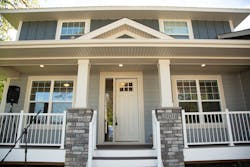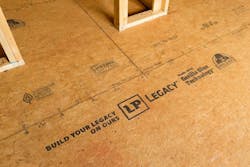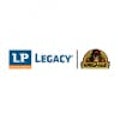Quality Materials Give Veteran Housing an Added Boost
This volunteer-built home in Minnesota offers transitional housing to female veterans.
When it comes to building homes for those in need, quality doesn’t have to, nor should it, take a back seat. In fact, well-built structures are essential for maintaining long-term budgets for the non-profit companies that manage the properties as well as to the health and well-being of those who reside there.
Quality was top of mind for the Minnesota Assistance Council for Veterans (MACV), BATC-Housing First Minnesota Foundation, and Lennar Homes when planning two transitional housing complexes for veterans and their families in 2017 and 2018.
The Minnesota Assistance Council for Veterans is a nonprofit organization that has been serving veterans and their families who are homeless or at risk of becoming homeless across the state for more 25 years. BATC-Housing First Minnesota Foundation partners with other organizations to provide safe,durable, and affordable housing for Minnesota’s homeless, veterans, and others in need. Its members and supporters volunteer their expertise and time giving back to the housing industry.
In 2017, the two nonprofits partnered with Lennar Homes to build a home where homeless veteran families, residing there one at a time, could transition rapidly into homes of their own. In 2018, they constructed a second house in Maplewood, Minn.,with transitional housing for up to five women veterans, a population that is in growing need of services in support of moving out of homelessness.
Bob Bennett, manager at the BATC-Housing First Minnesota Foundation, was in charge of sourcing products for the build. Although the houses are built through volunteer efforts and donated materials, Bennett was adamant that the quality of the homes not be sacrificed. He was also seeking products that would not delay construction schedules. Bennett had previously worked with local LP representatives for product donations on other MACV builds, and he had been very impressed with the product performance of LP’s sub-flooring and siding.
Knowing that callbacks could potentially push back the move-in date for the women veterans in need of housing, Lennar’s flooring contractor, Jeff Firkus of Contract Interiors, turned to LP Legacy sub-flooring. “We do a ton of new homes for Lennar and install a lot of hardwood over sub-flooring,” Firkus says. “Depending on how Mother Nature has her way with a project, it can affect the fastener holding power of our staples.”
Firkus played an integral role in Lennar’s adoption of LP Legacy® sub-flooring, and he says that before making the switch he’d receive callbacks about the hardwood popping and squeaking. He took it upon himself to test many different sub-flooring panels, including various grades and manufacturers, and determined that LP Legacy sub-flooring would be the best panel for reducing callbacks.
Indeed, LP Legacy sub-flooring is made with Gorilla Glue Technology® and offers superior moisture resistance, stiffness ideal for installation under hardwood flooring and tile, and high panel density for exceptional fastener holding strength.
In addition to donating LP Legacy sub-flooring,the manufacturer donated LP SmartSide® trim and siding products, providing a beautiful and durable exterior backed by a 5/50-year limited warranty.
The results were immediate. “I watched [the products] get installed, and everything is performing great,” says Lennar Project Supervisor Andrew Hartman. “We work with LP products often and haven’t had any concerns from our installers.”
Bennett shared his appreciation for the product donation. “LP has allowed us to put top-shelf, premium products in these houses that we know are going to last a long time. MACV doesn’t have to worry about the quality,” he says. “This home will probably last 80 to 100 years. Imagine how many lives the house will touch.”
Following the projects, Firkus gave LP Legacy sub-flooring the ultimate stamp of approval by using the panels in his own home.


